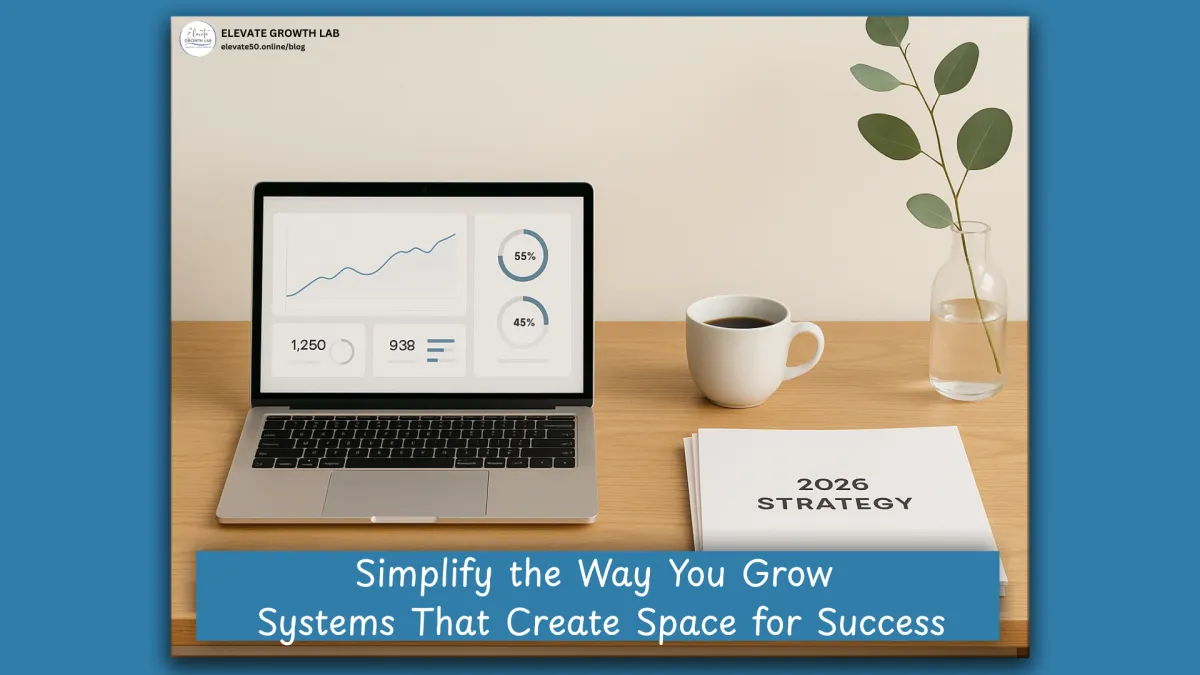
Feeling Stretched Too Thin? The 2026 Strategy That Helps You Grow Without Doing More
Every year, we set bigger goals, but without better systems, we end up repeating the same cycle of overwhelm.
If you’ve ever found yourself juggling all the moving pieces of your business and thinking, “There has to be an easier way,” you’re right. Growth shouldn’t depend on how much energy or time you can personally give. It should depend on the structure you’ve built to support that growth.
That’s where systems come in.
Systems are the bridge between your vision and reality; the invisible structure that keeps your business stable while you grow.
This article will walk you through what systems really are, why they matter for your 2026 goals, and when it’s time to start building them. And if you’re ready to go further, I’ll share how to get the free 2026 Systems Success Kit, your step-by-step guide to creating and automating systems that truly grow with you.
What Are Systems (Really)?
Systems are the repeatable, intentional processes that make success predictable.
They’re not just checklists or tech tools — they’re frameworks that organize your work so it can run smoothly without constant reinvention.
Think of them as the backbone of your business. They support your creativity, your client experience, and your income, even when you step away for a day (or a week).
Systems can take many forms, such as:
A marketing workflow for planning and scheduling content.
A client onboarding process that runs automatically and consistently.
A lead follow-up sequence that nurtures relationships without relying on memory.
A project management structure that keeps tasks organized and deadlines clear.
Visualize this: Your business is a highway, and systems are the lanes and signs that keep everything moving smoothly toward your destination — no traffic jams, no detours.
Why We Need Systems and What Problems They Solve
When most business owners think about growth, they imagine adding more clients, more sales, or more revenue. But true growth often starts by reducing the chaos behind the scenes.
Here’s what happens when systems enter the picture:
Chaos → Clarity
Systems stop you from reinventing the wheel every day or every week. You know what needs to happen, when, and how to free up time and headspace for higher-level strategy.
Inconsistency → Predictability
A well-built system creates dependable results across every area of your business, from steady revenue to a consistent client experience and a team culture that thrives on clarity. Your business keeps running even when you’re not in it every minute.
Stagnation → Scalability
Systems help you grow your income without growing your hours. They make it possible to delegate, automate, and expand your reach without working harder.
Stress → Simplicity
When routine tasks are structured and predictable, your brain can finally focus on creativity, innovation, and connection — the things that truly move your business forward.
For example: automating your client onboarding process can give you back hours each week. It’s not just about efficiency, it’s about peace of mind. You can take a breath knowing every new client feels supported and seen from day one.
When to Build or Update a System
The best time to create or refine a system isn’t when things are falling apart. It’s when you start feeling the strain of doing everything manually.
Here are a few signs it’s time to systemize:
You find yourself doing the same task more than once or twice a week.
You can’t take a day off without something slipping through the cracks.
You’re turning down opportunities because your plate feels too full.
Delegating feels impossible because everything “lives in your head.”
When these moments show up, it’s time to pause and ask yourself:
If my business doubled next year, what would break first?
What’s taking up most of my time each week, and how could it be systemized, automated, or simplified?
Which daily or weekly tasks could be turned into simple systems to free my focus for growth?
Your answers to these questions reveal where structure can create the biggest transformation.
How Often to Review and Refresh Your Systems
Even great systems need maintenance. What worked last year may not fit your next stage of growth.
Quarterly Check-Ins:
Every 90 days, review 1–2 systems. Ask: Are they still efficient? Are any steps unnecessary or outdated?
Annual Optimization:
Each system deserves a deeper look once a year. Consider what’s changed in your business: new tools, offers, or team members, and make sure your processes still align.
What to Look For:
Repeated mistakes or skipped steps
Bottlenecks caused by one person or tool
Redundant or overlapping processes
Missed opportunities for automation or delegation
Put a recurring “System Review” date on your calendar each quarter and block the full day out as busy. It’s a small commitment that prevents massive headaches later.
2026 Mindset: Systems That Grow With You
As we head into 2026, remember this: systems aren’t about restriction. They’re about freedom through structure.
The goal isn’t to perfect every process or automate every detail. It’s to design systems that evolve with you. The more clarity you create behind the scenes, the more energy you’ll have to show up fully in your work.
So instead of asking, “How can I do more?”
Ask, “How can I make what I already do easier, smoother, and more sustainable?”
That’s what true scalability looks like.
Growth in 2026 isn’t about doing more; it’s about designing smarter ways to support the business owner you’re becoming.
Ready to Turn Insight Into Action?
You don’t have to build your systems from scratch. I’ve already done the heavy lifting for you.
Get your free 2026 Systems Success Kit, a practical workbook that helps you design, document, and streamline your business systems. Inside, you’ll find step-by-step templates, automation ideas, and free or low-cost tools to save time, reduce overwhelm, and build systems that scale with you next year.
Download the 2026 Systems Success Kit Here 👇

